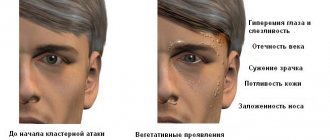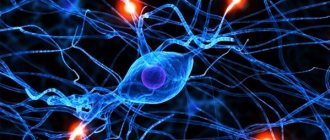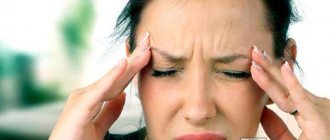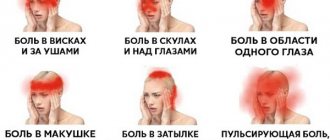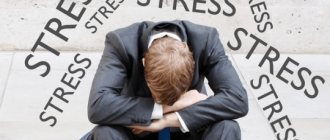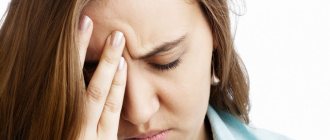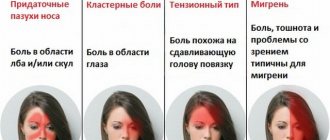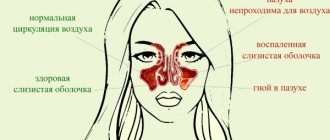Causes of pulsation in the head
When there is pulsation in the head, the state of the body becomes unbearable for a person - discomfort interferes with work, rest, and doing usual things.
Often, throbbing pain cannot be eliminated even with the help of potent drugs. If such an ailment is permanent, then you should think about the reasons for its occurrence and possible negative consequences for human health. Pulsation in the back of the head is accompanied by the following symptoms:
- dizziness;
- cardiopalmus;
- nausea;
- feeling of weakness;
- change in the nature of pain from bursting to pressing;
- When you tilt your head down, the pain intensifies.
A pulsating headache in the back of the head can also be triggered by diseases of the cervical spine (scoliosis, osteochondrosis). The cause of pain in the back of the head is pinching and compression of the blood vessels/nerves in the neck.
Associated symptoms of pathology:
- stiffness of the back or neck muscles;
- convulsions;
- sharp pain in the head when bending over;
- sleep quality disturbance;
- loss of appetite;
- memory impairment;
- changes in voice timbre;
- visual impairment;
- the appearance of noise or ringing in the ears.
Causes of the condition when pulsating in the temples:
- vegetative-vascular dystonia;
- arterial hypertension;
- intoxication of the body;
- migraine;
- physical or mental stress;
- hearing diseases.
As a rule, throbbing pain is accompanied by:
- weakness;
- changing the pressure norm downward or upward;
- nausea;
- rapid heartbeat;
- dizziness;
- increased sweating;
- feeling of lack of air.
Causes of inflammation of the trigeminal nerve:
- hypothermia of the body;
- injuries;
- herpes virus activity.
The main causes of the condition when a headache appears in the frontal part are:
- increased intracranial pressure;
- intoxication of the body due to ARVI;
- eye diseases;
- inflammation of the paranasal sinuses;
- inflammatory processes in brain tissue (benign or malignant).
Associated signs of pathology are:
- nausea;
- disturbance of consciousness;
- functional impairment of the organs of hearing and vision;
- convulsions.
Throbbing pain can manifest itself in several forms:
- short-term;
- long-term;
- strong;
- weak;
- aching;
- sharp.
Causes of short-term pulsation in the head:
- abuse of bad habits, as well as “bad” products (coffee, strong tea, chocolate products, etc.);
- age-related changes;
- change in weather conditions;
- maintaining an inactive and passive lifestyle;
- psychological factor (stress, severe frustration);
- uncomfortable position or place to rest (sleeping on a hard mattress);
- physical stress;
- mechanical pressure on the surface of the head (tight hairstyles, wearing uncomfortable or heavy hats).
When a headache in the back of the head worsens, this condition can become a symptom of a serious disease (aneurysm, vegetative-vascular dystonia, glaucoma, atherosclerosis, sinusitis, meningitis, etc.). If the back of the head suffers from pain, then these may be problems of a dental or neuralgic nature.
Stressful situations, cervical osteochondrosis, and kidney problems most often provoke pain in the back of the head on the right. And pain on the left appears due to cervical migraine, middle ear infection, intracranial tumor.
Strong throbbing in the head cannot be tolerated. As soon as acute and persistent discomfort appears, it is necessary to urgently call an ambulance. Before the arrival of qualified doctors, you need to provide first aid yourself. What is needed for this?
- Take painkiller medications - Paracetamol, Ibuprofen, Analgin, Nimesulide, Nurofen, etc.
- Take a horizontal body position, while preferably raising your legs to a slight elevation. It is important not to tilt your head down.
- Calm down and remove all sources of irritation from the room (noise, bright light, etc.).
- If you have a headache, apply a cold compress to the sore spot. This method helps relieve acute pain.
- If your physical condition allows, then take a contrast shower or bath with a decoction of soothing herbs (melissa, mint, chamomile).
- Eliminate bad habits - do not smoke, do not drink alcohol.
- Drink a glass of herbal tea based on oak bark or chamomile and mint.
- Perform a gentle massage of the neck and head.
Causes of headaches
The main causes of pain in the temporal zone or in the occipital region can be determined after diagnosis; they can be as follows:
- Smoking. As soon as nicotine enters the blood, the blood vessels begin to narrow sharply, and as a result, the pressure increases. Therefore, at the first puffs a person feels dizzy, but after a short time the condition returns to normal. Smoking is often accompanied by a cough, as tobacco smoke irritates the bronchi.
- Allergens - if they get on the mucous membranes, irritation begins and a strong dry cough appears. The result of this phenomenon is swelling of the maxillary sinuses. Breathing worsens, insufficient oxygen reaches the brain, which provokes pathology.
- Meteor dependence. There are many people in the world who are dependent on fluctuations in atmospheric pressure. Infants and the elderly are especially susceptible to this. Your head may hurt when the weather changes, and coughing only makes the situation worse. Typically, pathology forms in the occipital and temporal regions. This is due to vascular spasms. When the pressure drops rapidly, dizziness begins.
- Arnold-Chiari syndrome. This is a hereditary pathology - the cerebellum does not work correctly, coordination of movement is impaired. One of the formation factors is the woman’s abuse of alcohol and tobacco during pregnancy. Excessive use of drugs leads to intoxication of the body as a whole, which enhances the development of the syndrome. The disease is incurable - the patient’s condition is maintained by constant medication. When coughing, he experiences discomfort in the occipital area, which occurs along with bronchospasms.
- Sinusitis is suppuration of the nasal sinuses, which causes coughing. Pathology occurs with sinusitis, when even bending down causes vascular spasms. This is explained by the presence of a purulent component in the tissues and a lack of oxygen, which affects the brain. With frontal sinusitis, pain may appear in the area of the frontal part of the head.
- Osteochondrosis is instability of the cervical spine, discomfort occurs when coughing and overwork.
- Neuralgia is pain that shoots and pulsates. When coughing, it only intensifies and becomes unbearable.
If, with a headache, the patient feels nauseous, vomiting, and weakness, but the body temperature is not elevated, this is most likely the result of general intoxication of the body, which often accompanies stomach infections.
There is a more serious cause of this pathology - oncology, with this disease pain can occur in any part of the head. Neoplasms grow for a long time without producing any symptoms. As the tumor grows, the patient experiences more frequent spasms, which are aggravated by coughing, sudden head turns, bending, and sneezing.
Main causes and diseases
Head pain is a serious reason that forces people to pay attention to their health, since it is quite difficult to endure them, and it is also difficult to engage in any activity at this moment. The causes of headaches can be different - from stress to diseases, the occurrence or presence of which the patient may not even suspect. It also matters after what and how the headache hurts; this can also indicate a specific cause of discomfort anywhere in the head.
Almost every person has experienced pain in the head when bending over at least once in their life. Such cases are observed in patients both as a one-time manifestation and as a constant symptom, which signals that a process is occurring in the body or the presence of pathological changes in the human body.
One-time pain can be caused by the following objective reasons, in addition to pathologies:
- Overwork. The body, exhausted during the day, gives a warning about a loss of strength.
- Insufficient sleep time. The same as in the first case.
- Adverse habits (smoking, alcohol) that affect human health.
- Insufficient physical activity during the day. That is, a person moved little during the day or was in one position for a long time.
- Sudden standing up and bending over. The situation is similar to the previous one.
- Stress or emotional fatigue (exhaustion, overwork).
- Lack of vitamins in the body or poor nutrition.
- Sensitivity to changes in weather conditions.
- It can be considered as a side effect of the drugs that the person is currently using.
There is no need to worry too much if the spasm only happened once, but you can and should reconsider your lifestyle and try to avoid making the same mistakes that provoke discomfort in the head area.
Important information
If the pain is periodic, then you need to pay special attention to this, notice the accompanying symptoms and seek advice and diagnosis from a doctor.
Typically, there is a group of causes or diseases, the symptom of which is headache when bending over:
- Viral and colds (ARI and ARVI). During the period of illness, the patient’s general health deteriorates, so some physical activity may cause discomfort. It will be especially noticeable if you have a runny nose.
- Cervical migraine, which provokes spasms further along the nerve endings.
- Overexertion, which results in a headache that worsens with physical activity or a sudden change in the position of the patient’s head or body.
- Flu. Just like other colds transmitted by humans. In most cases, the cause of symptoms is determined by fever, runny nose, and fatigue.
- Intracranial pressure. When there are changes or interruptions in work, spasms and symptoms are felt, which only become stronger if the person moves or rotates his head.
- Sinusitis. Fluid or pus accumulates in the maxillary sinuses and does not have a normal outflow, which causes discomfort. They may intensify if the patient bends over.
- Brain tumors are both benign and malignant. The presence of tumors in the brain can affect normal functioning and provoke the development of spasms.
These are the most likely reasons why your head may hurt when bending down. The following diseases can also be considered: anemia, cardiac dysfunction, pathological changes in the structure of blood vessels. It is worth paying attention to the neck, since discomfort in this place can radiate along the nerve endings. This usually occurs when there are diseases of the cervical region or when the neck muscles are tight.
All these diseases and pathologies are considered as provocateurs of spasms. But the sensations become stronger if a person was in an uncomfortable position for a long time, and then suddenly decided to change his body position.
Do not forget about the reasons that provoke spasms - allergies or food, chemical poisoning, which leads to intoxication, with such symptoms, is a certain signal.
https://www.youtube.com/watch?v=https:1r70iLRXE2U
In addition, in the tilted position there are symptoms associated with this sensation:
- extraneous sounds in the ears;
- dizziness (blurred consciousness);
- memory loss;
- temperature increase.
When a person experiences periodic or frequent spasms even in a normal position, it is worth seeking advice. It will help the doctor to understand the whole picture if a person notices what symptoms occur after, and what other unpleasant sensations there are.
To begin with, they usually contact a therapist, who can refer you to another specialist for a more accurate examination. Mainly to a surgeon, neurologist, cardiologist.
What treatment options are there?
Conservative.
Sinus pain when bending forward will subside only after the underlying disease is completely eliminated. To treat sinusitis, doctors usually prescribe antibiotics and corticosteroids. Typically, the course of taking medications lasts 10 days; for chronic sinusitis, the duration can increase to 3 weeks. Nasal sprays help relieve allergies and improve the general condition of the body by eliminating sneezing and itching.
Surgical.
If treatment fails, endoscopic surgery may be considered. It is possible to remove polyps or spurs that are preventing a full recovery. Sometimes the only way to get rid of sinusitis is to open the sinuses.
Folk.
We must not forget about simple methods that will significantly help alleviate the course of the disease:
- using a humidifier;
- rinsing the nose with a solution of sea salt;
- massage especially painful areas of the face, neck, head.
Interestingly, some dietary supplements may help treat bending headaches by targeting inflammation in the sinuses. These are enzymes derived from natural sources, usually fruits; They should be taken under the supervision of a doctor.
Skullcap, St. John's wort, wild rosemary, mullein, lemon balm and some other herbs can play a significant role in the fight against sinusitis, as they affect the thickness of mucus produced and overall immunity. There are restrictions: herbs that thin the blood are contraindicated for pregnant and lactating women.
Comprehensive treatment will be the most effective; in addition to taking antibiotics, it is necessary to temporarily reconsider your lifestyle: use a humidifier, breathe in steam, spend more time in nature, avoid irritants (such as smoking areas and stuffy rooms). A headache when bending forward will go away much faster if you carefully follow all the doctor’s recommendations.
Throbbing pain in the head: causes and treatment
Very often, throbbing pain in the left side of the head is caused by a migraine attack, which, in turn, can be provoked by such unfavorable factors as:
- stressful situations;
- mental stress;
- consumption of harmful foods;
- abuse of alcoholic beverages or other bad habits;
- weather changes.
The sensation of pulsation in the head may be accompanied by the following symptoms:
- intense pain;
- nausea;
- photophobia;
- visual impairment;
- noise in ears.
For migraine character and throbbing pain in the right side of the head. The distinctive signs of this pathology are:
- throbbing headache worsens with physical strain, exposure to bright light or loud noise;
- nausea;
- urge to vomit;
- feeling of lack of air;
- the appearance of hallucinations;
- impaired functionality of the organs of hearing and vision.
The throbbing pain in the head may not stop for 2-3 hours, which causes severe suffering to the person.
Every person knows the state of pulsating in the head. In most cases, the occurrence of painful symptoms is not given importance. However, a throbbing headache can signal the development of pathological processes in the body. Let's look at why pain occurs and how to get rid of it.
Pulsation in the head can occur under the influence of both external and internal factors.
In the first case, the painful symptoms are safe and do not pose a threat to human life and health. Pathological manifestations may occur against the background of:
- lack of fresh air, for example, in a bathhouse;
- excessive consumption of alcoholic beverages;
- excessive physical activity;
- lack of sleep;
- weather dependence;
- active hormonal changes, especially in women during pregnancy and menopause;
- unstable psycho-emotional state;
- strict diet or fasting;
- intense mental stress;
- severe fatigue.
In such cases, a person experiences pulsation in the head without pain. When unfavorable conditions are eliminated, health improves.
The situation is much more complicated when the sensation of pulsation in the head acts as a concomitant pathological symptom against the background of the underlying disease. We list the main diseases that can cause throbbing headaches:
- Migraine attacks. Accompanied by sharp pulsation.
- Osteochondrosis of the cervical spine. Usually occurs in people engaged in sedentary work.
- Atherosclerosis of blood vessels. Patients often experience pounding in their temples.
- Inflammatory processes in the ENT organs. For example, with otitis media, pulsation may appear behind the ear on the right or left.
- Cardiovascular pathologies, most often associated with disturbances of vascular tone.
- Hypotension or hypertension. Typically causes pain in the top of the head.
- Cluster headaches. Strong pulsation occurs unexpectedly, on the left side of the head or on the right.
- Neuralgia, for example, inflammation of the trigeminal nerve. The processes of the neuron extend to the facial part, so the throbbing headache also spreads to the temples, nose, and ears.
- Caries, periodontal disease. In advanced cases, toothache sharply radiates into the head with a pulsation.
- Neoplasms. During the development of tumors, morning throbbing and headache usually occur.
- Colds. Throbbing pain in the head is accompanied by increased body temperature.
In such cases, in order to get rid of a throbbing headache, you will need to undergo diagnostic procedures to determine the pathology that causes it. After completing the course of treatment, the pain will subside.
At night, pain and throbbing in the head are most often felt by patients suffering from VSD. The fact is that the disease disrupts the regulation of blood vessel activity. Under such conditions, their lumen may unexpectedly expand or contract.
This negatively affects the blood supply to all organs, especially the cerebral cortex. Lack of oxygen and nutritional compounds in the cells of the central nervous system causes pain. During the daytime, the patient is able to keep blood pressure levels under control and quickly eliminate pain and pulse in the head.
At night the situation gets out of control. In addition to a throbbing headache, the following symptoms may appear:
- dizziness;
- weakness;
- increased sweating;
- numbness of the upper and lower extremities;
- depressed mood;
- paleness of the skin;
- heart rate too high.
https://www.youtube.com/watch?v=https:rynddUOIvC8
Types of head tremors: Parkinson's disease and Holmes tremor
Painful signs persist in the morning and worsen with movement, especially when getting out of bed.
Also at night, throbbing pain in the parietal part of the head may appear in the presence of hypertension or hypotension.
A sharp, throbbing headache is a common symptom of migraine attacks. The true cause of the disease has not yet been established. Most medical professionals associate the occurrence of migraines with the presence of diseases of the central nervous system or cardiovascular system. Additionally, the following unpleasant sensations appear:
- photosensitivity;
- intolerance to loud sounds;
- nauseating feeling;
- gagging;
- shooting pain in the ear, feeling of the presence of a foreign body in the ear canal;
- lack of appetite;
- irritability;
- increased fatigue.
With this pathology, the head hurts very badly and a sharp pulsation is felt. In ninety percent of cases, the pain is localized on one side. Often, patients note that it is pulsating on the right side of the head, or on the left.
Migraines should never be left untreated. If neglected, the disease can become chronic or develop into dangerous conditions such as status migraine or migraine stroke. Therefore, if you feel a strong pulsation in the head on the left or right, you should immediately consult a doctor.
If a person often feels that neck pain radiates to the head and causes throbbing, he should be examined for the presence of cervical osteochondrosis. During illness, the cervical vertebrae of the spinal column are displaced and deformed.
As a result, a large vessel supplying blood to the cerebral cortex is compressed. It is the disruption of blood circulation in the central nervous system that causes pain in osteochondrosis.
In this case, the throbbing pain is concentrated in one place, most often in the occipital region, or spreads to the entire head.
Additionally, the sick person feels:
- numbness of the upper extremities;
- auditory and visual hallucinations;
- nervousness;
- absent-mindedness;
- impaired coordination of movements;
- lethargy.
A characteristic feature of the disease is the deterioration of the patient’s well-being when moving, for example, when bending.
In situations where a person feels a pulsating noise in the ears and head, he will need to take a blood test for cholesterol. Such symptoms usually signal the formation of atherosclerotic plaques on the walls of blood vessels.
The narrowing of their lumen makes it difficult for unhindered blood circulation throughout the body. Therefore, in order to push it through, the vascular walls are forced to actively contract. Such conditions lead to throbbing pain in the head.
In addition, the patient’s condition is aggravated by the following painful signs:
- dizziness;
- increased fatigue;
- deterioration in concentration;
- insomnia;
- weakness.
Important! Atherosclerosis must be treated. The disease can be fatal.
To get rid of pulsation in the head, the first thing you should do is visit a general practitioner - a therapist. First, the specialist will conduct a detailed interview with the patient. To restore a complete picture of the development of the disease, the patient will need to accurately describe his feelings.
For example, “when I suddenly get out of bed, I hear a pulsation in my ears, and the left side of my head hurts.” After collecting a primary history, the therapist will refer the patient to a specialist. For example, if cardiovascular pathologies are suspected, an examination by a cardiologist will be required. If there are symptoms of sinusitis, see an ENT doctor.
If migraine attacks develop, it is worth visiting a neurologist.
The relationship between physical activity and headaches
Examination methods
Before you try to get rid of painful symptoms, you need to find out why your head may be throbbing. The causes of pain are the main criterion when prescribing a therapeutic course.
In most cases, when a patient experiences a throbbing headache, medical professionals will prescribe the following diagnostic procedures:
- laboratory testing of blood and urine;
- CT, MRI of the central nervous system;
- measuring blood pressure at rest and during physical activity of varying intensity;
- radiography;
- Ultrasound of the cardiovascular system.
In complex cases, if there is doubt about the diagnosis, the listed diagnostic procedures can be supplemented with other examinations.
If there is a final diagnosis, the medical professional will select the optimal course of treatment. It will be completely aimed at eliminating the underlying disease, which leads to such unpleasant sensations as throbbing pain in the head.
For example, if there are atherosclerotic plaques, the patient will be prescribed a special diet, as well as taking the following medications: Crestor, Lescol Forte, Lipostat, Nicotinic acid. With VSD, the patient will be helped by proper rest and medications such as Mexidol, Eltacin, Afobazol.
The following medications can be used as first aid for throbbing pain in the head:
- Tempalgin;
- No-shpa;
- Citramon;
- Aspirin;
- Paracetamol.
Important! Taking any medications must be agreed upon with a doctor. Self-medication can cause serious harm to health.
Also, if there is pain, you can use proven folk remedies. For example, a herbal decoction based on St. John's wort, mint and lemon balm. Within twenty minutes, a fresh cabbage leaf applied to the forehead can eliminate pulsation in the head.
Throbbing pain in the head is not only a source of discomfort. Such pathological manifestations can act as alarming signals about the development of pathological processes in the internal environment of a person. Therefore, in order to avoid adverse health consequences, if pain occurs, you should immediately contact a specialist.
When you cough, your head hurts: why does the pain radiate to the forehead, temple or back of the head?
A condition where a headache occurs when coughing often occurs against the background of respiratory infections. An unpleasant symptom can appear during inflammation of the paranasal sinuses and otitis media. There are other causes of headache (cephalalgia) when coughing, which not only significantly worsen overall health, but can also pose a serious threat to life.
Arnold-Chiari syndrome
With this rare congenital pathology, the brain structures (tonsils) descend inside the head and become wedged into the bone of the posterior cranial fossa. It manifests itself as pain in the occipital and cervical region. It hurts especially when coughing and sneezing. Other symptoms of Arnold-Chiari syndrome:
- vomiting (not related to food);
- speech problems;
- decreased visual acuity, double vision;
- difficulty swallowing;
- tinnitus against a background of heaviness in the head;
- snoring at night;
- reflux of liquid or food into the nose;
- motor disorders.
Symptoms appear depending on the severity of the pathology.
Other reasons
Other pathologies can cause coughing attacks with a headache in the back of the head - a benign or malignant neoplasm in the brain, a cyst, an aneurysm. All of them require immediate contact with specialists.
Diagnostics
A comprehensive examination prescribed by a specialist helps determine the cause of a headache when coughing. Diagnostic procedures are determined depending on the suspicion of a particular pathology:
- MRI of the brain;
- Ultrasound of the vessels of the head and neck with measurement of the speed of blood movement through them;
- encephalogram;
- laboratory tests (general blood and urine analysis, cerebrospinal fluid analysis, blood biochemistry for electrolytes, creatinine, urea, cholesterol).
What to do if you have a headache due to coughing
A single case of cough that causes discomfort in the head is not terrible. But if your head hurts with a certain frequency or your cough does not go away for more than two weeks, you should consult a doctor. A specialist will be able to accurately determine the cause of headache and cough and prescribe adequate treatment.
First aid
A child or adult has a cough that causes a headache - a reason to put everything aside and rest. Warm tea with mint, lemon, a calm atmosphere in the house is what you need to make your head feel better.
You need to measure your temperature. Perhaps the cause of the malaise is an incipient ARVI or influenza.
The patient should be isolated from other household members, put to bed, and a cool compress placed on the head.
If you have hypertension, your blood pressure must be measured. If your head hurts for several hours, the discomfort intensifies, and medical help is required.
Drugs
Doctors prescribe medications for coughs and associated cephalalgia based on the cause of the ailment.
- For viral infections (ARVI) and weather dependence, general restoratives (vitamin C, preparations based on echinacea, Rhodiola rosea) are recommended.
- Antiviral drugs (Amantadine, Influcein) are prescribed to treat influenza.
- Bacterial infections are treated with antibiotics.
- Mucolytics (Bromhexine, Ambroxol, ACC) help remove phlegm and alleviate the condition.
- Allergy sufferers are prescribed antihistamines (Loratadine, Eden); during an asthma attack, inhalation with Salbutamol is required.
- When the cause of cephalgia is heart problems and hypertension, antihypertensive drugs are required (they are selected individually). Diuretics and other medications are prescribed by a cardiologist depending on the manifestations of the disease.
- If your head hurts, but there are no signs of inflammation or serious condition, you can take Tempalgin, Nurofen, No-Shpu.
Taking medications for headaches and colds must be combined with drinking plenty of fluids.
Folk remedies
Herbal teas made from chamomile, calendula, mint, and thyme relieve inflammation, soothe, and act as general tonics. A decoction of raspberry branches helps relieve fever, cough and heaviness in the head during a cold. For coughs and headaches, it is recommended to drink 200 ml of warm infusion three times a day.
Non-drug therapy
Headaches and coughs not associated with infections or serious pathologies of internal organs are treated with physiotherapy and traditional medicine. Help to restore good health:
- contrast water procedures (showers, hand and foot baths);
- acupuncture;
- massage (especially for osteochondrosis), physical therapy;
- aromatherapy (pine oils, eucalyptus, geranium).
- regular walks in the fresh air.
Asthmatics and people with allergies are prescribed a diet low in simple carbohydrates and exclude foods that provoke exacerbation. Speleotherapy sessions - staying in a salt room - work well.
Source: https://tden.ru/health/pri-kashle-bolit-golova
When is urgent medical attention needed?
Many patients try to ignore some symptoms and continue with normal life. You should listen to your body. If you have one-time symptoms, you shouldn’t be particularly concerned; perhaps they are due to an incorrect daily routine, nutrition, incorrect body position, or other objective reasons not related to diseases in the body.
As for periodic or constant pain, you cannot tolerate or wait it out, much less allow self-medication, since the cause itself is unclear.
Important information
Headaches and headaches are serious reasons to see a doctor. Here, just like with the heart, control and verification are needed, otherwise everything can end in serious complications.
Such manifestations can be noticeable or hidden, sometimes worsen, sometimes stop. Moments of exacerbation must be diagnosed. This way you can understand at what period and why the spasm begins.
In the following conditions, you must immediately consult a doctor; if this is not possible, call an ambulance:
- Too much sudden pain that the patient has never experienced before.
- Constant severe headaches for people over 50 years of age.
- If accompanied by impaired speech, vision, coordination. There is weakness.
- Sharp pain lasting more than a day.
- At the same time, the eye sockets hurt.
- Accompanied by fever, numbness of the back of the head. Vomiting is also observed.
In these cases, one can think of brain problems, so urgent diagnosis and treatment are necessary.
Symptoms
With a dry, intensifying cough, pain occurs in the back of the head, in the forehead and temples. It can be unbearable: stabbing, aching, shooting. This makes a person feel uncomfortable.
- painful sensations when straining when the patient tries to cough or sneeze;
- attacks that can last for hours;
- often the pathology is accompanied by a ringing in the ears, fever, dizziness, depression and loss of consciousness.
There are patients who, when visiting a doctor, complain of a headache when coughing, radiating only to one side of the cerebral hemisphere. It often develops into a protracted stage and torments a person with periodic attacks over many years, sometimes suddenly disappearing for a long time and then returning again.
Features of diagnosing pain in the head when lowering the head down
If a child or adult has a headache when bending down, an ENT doctor examines the patient to diagnose or rule out the presence of sinusitis. If the diagnosis is not confirmed, the following diagnostic measures are prescribed:
- ECG.
- Tomography of the brain.
- X-ray of the spine, nose, frontal part.
- Blood and urine tests.
- Skin allergy tests.
Depending on the research results, the therapist prescribes a consultation with a neurologist, cardiologist, allergist or traumatologist.
If you get a headache when bending over, you need to diagnose these conditions either in a paid clinic or in a clinic. They visit the following specialists and subspecialists: therapist, neurologist, surgeon, ENT specialist and others. Diagnostic methods are mainly prescribed:
- ECG;
- urine and blood tests;
- skin allergy tests;
- X-ray of the nose, forehead or spine;
- CT or MRI of the brain.
These methods are the most general; if a deeper study of the situation is necessary, the doctor prescribes additional methods. After receiving the results, the doctor may refer you to another specialist to prescribe a course of treatment.
After a patient contacts a medical facility, the doctor must carefully examine the symptoms of the pathological condition. An initial examination of the patient and the nature of the complaints will help make a preliminary diagnosis of the disease. To confirm the diagnosis, a number of studies are necessary.
- Taking blood and urine tests.
- MRI of the neck and head.
- CT scan.
- Electrocardiography.
- Angiography.
- Ultrasound of internal organs.
- Spinal puncture - if meningitis, brain tumor, encephalitis is suspected.
- Vision diagnostics.
- Dental examination.
Diagnostics
When a patient complains of a headache when coughing, first of all you need to find the cause of its occurrence. The main thing that should be ruled out is the presence of a tumor inside the skull.
The main activities will be:
- taking anamnesis;
- conducting laboratory research;
- ultrasound examination of cerebral vessels (brachiocephalic and intracranial);
- measuring the speed of blood flow in the specified vessels;
- magnetic resonance imaging of the head.
Treatment at home
In order to reduce pain, nasal drops are used, but if they were not prescribed, you can use them for up to 3 days. As home treatment use:
- nasal humidifier;
- massage;
- inhalation;
- gymnastics;
- physical activity and physical therapy that strengthen the neck muscles.
If the doctor does not prescribe additional treatment, then you should not abuse self-medication. You can eliminate symptoms if they are very bothersome and there is no way to consult a doctor.
Prevention
Measures to prevent headaches after coughing depend on what caused it. If this is an allergy, then you should, if possible, prevent contact with allergens and always carry antihistamines with you. If you have a bronchial asthma, it should always be in a person’s pocket or bag.
If you have a headache in the forehead due to smoking, then you will have to give up this bad habit.
Prevention of colds will include measures known to everyone, but no less effective:
- hardening (with gradual daily cooling of the water temperature for dousing by 1 degree);
- walking in the fresh air;
- physical activity, sports;
- proper nutrition;
- rejection of bad habits;
- healthy sleep at least 7-8 hours daily;
- taking vitamins (agreed with the attending physician) during periods of active ARVI.
Remember, if you have a headache or cough, you should avoid self-medication and wait. Only contacting a specialist and following his recommendations will help cure the disease and restore health.
Source: simptom.guru
Traditional methods of treatment
Usually the following folk methods are used:
- Let the onion peel sit for about an hour and strain. Drink half a glass twice a day (up to 3 days).
- Compress (cold) on the area that is bothering you.
- Apply a cabbage leaf to the area of pain.
- Aromatherapy. Any pleasant smells that would not provoke a new attack.
- Pain in the head when bending down: causes
- Throbbing pain on the left side of the head
- Headache on the right side of the head causes
- Throbbing lower back pain causes in women
Etiology [causes]
Men over forty years of age are most susceptible to headaches when coughing. They suffer from this four times more often than women.
The nature of the pain is as follows:
- the attack is short-lived, from several seconds to several minutes. Maximum duration – half an hour;
- very strong and intense pain;
- in most cases, diffuse pain (in the forehead, temples, back of the head simultaneously or in turn), but in a third of cases it is unilateral. At times it becomes chronic;
- Most often my head hurts when I cough.
Experts call the second most common lesion of the peripheral nerve in the neck area. In other words, cervical neuralgia. Its peculiarity is that it manifests itself not only during coughing, but also when turning or tilting the head, as well as any other sudden movement. Neuralgia is mainly caused by drafts.
In the presence of cervical osteochondrosis, the source of pain is concentrated in the occipital part of the head. The unpleasant sensations are accompanied by tinnitus, dizziness, and attacks of lightheadedness (nausea).
This is due to reasons such as:
- high pressure in the blood vessels of the brain;
- lifting heavy things, sneezing, sudden bends, squats and other physical activities;
- the body's reaction to acute respiratory viral infections and lower respiratory tract infections;
- smoking;
- allergies to dust, smoke, pollen, etc.;
- bronchial asthma;
- changes in the structure of the brain.
Smoking disrupts the functioning of the heart and blood vessels. The heart rate increases and blood pressure rises. The body signals nicotine poisoning through cough, headache, nausea, shortness of breath and other signs.
Another reason for combining a headache with a cough is weather dependence. You need to understand that sensitivity to weather changes in most cases comes “together” with other pathologies, such as:
- heart and vascular diseases;
- diseases of the musculoskeletal system;
- genitourinary diseases;
- diseases of the nervous system;
- weakened immunity.
It is most difficult for those diagnosed with vegetative-vascular dystonia or congenital heart disease. Persons with diseases of the respiratory system are also susceptible to dependence of their well-being on changes in atmospheric pressure.
An asthma attack begins with a feeling of pressure in the chest and a dry cough. It is difficult to breathe, wheezing and whistling appear. Due to frequent breathing, a person experiences oxygen starvation, which causes blood pressure to rise. The attack ends with a wet cough and thick sputum. If the wheezing and whistling stop, but no wet cough occurs, this is a signal that the person needs urgent resuscitation due to a blocked airway.
Any cold is accompanied by a headache and cough. Coughing clears phlegm from the airways and lungs, which promotes recovery. Such a headache appears due to poisoning of the body, and intracranial fluid presses on the lining of the brain. In this situation, this is normal, as it is associated with the disease. That is, with bronchitis, sinusitis, sinusitis or ARVI, a short attack of pain in the head during the so-called “clearing of the throat” is not scary.
If a person has a chronic cold - sinusitis or sinusitis, then the forehead may hurt during the slightest cough. This is because chronic sinusitis is a constant inflammatory process in the sinuses of the forehead and nose; accordingly, the mucous membranes are also constantly irritated. The accumulation of purulent masses and sputum when coughing gives pain to the head.
With chronic bronchitis (which in itself is dangerous because it can develop into bronchial asthma), coughing attacks are so strong that they bring a person to vomiting. This no longer causes a short-term attack of pain, but a real long-term headache. People prone to migraines run the risk of coughing and having an unplanned attack.
If a person has Arnold-Chiari syndrome, headache from coughing and sneezing is one of the symptoms. Be sure to consult and then be examined by a doctor. If the syndrome exists, it means the brain is not developing correctly, and the cerebellum is deformed. Because of this, cerebrospinal fluid (intracranial fluid) circulates incorrectly.
The difference between an allergic cough and a cold is as follows:
- always appears accompanied by a headache as a result of exposure to an allergen;
- lasts more than three weeks;
- not accompanied by weakness, fever, chills;
- companions are itching, lacrimation, runny nose;
- The cough is mostly dry.
Primary cough headaches do not require intensive drug treatment in most cases. However, it can also signal serious pathologies.
General recommendations for diagnosis and therapy
After the first episode of headache, it is better to get examined immediately. First of all, you need to consult a neurologist, cardiologist, or ENT specialist.
Only after a detailed survey and examination will a specialist be able to make a preliminary diagnosis and prescribe a set of diagnostic procedures to clarify the diagnosis.
In most cases, complex diagnostics are prescribed, including instrumental and laboratory research techniques.
Therapy is selected based on the final diagnosis. A comprehensive course of treatment is selected for each patient individually, taking into account all his characteristics.
Source: 1golovabolit.ru
Medical indications
If your head hurts when bending over, you shouldn’t panic right away. Sometimes the process is based on non-medical factors, including:
- frequent, intense nervous strain;
- stressful situations;
- long-term depression;
- chronic fatigue.
If you have a headache, the cause may be alcohol or drug addiction. Some medications may cause pain. In this case, pain is a side reaction of therapy.
Therapy
Treatment for headaches is prescribed based on the underlying cause of the pathology. If the patient experiences pain only during coughing, analgesics are often prescribed: acetylsalicylic acid or Analgin. The attacks themselves can be relieved with the help of antispasmodics and drugs that reduce intracranial pressure.
Medicines
Headaches when coughing can be relieved with the following remedies:
Citramon tablets
- NSAIDs (non-steroidal anti-inflammatory drugs) are taken for acute inflammatory processes: Citramon, Ibuprofen.
- Antispasmodics are used if the pain is caused by vasoconstriction: Baralgin or No-Shpa.
- Muscle relaxants help with severe strain in the neck muscles: Tubocurarine.
- Antibiotics and antiviral agents are taken when the disease occurs against the background of viral or enterobacterial infections.
- Cough lozenges - relieve sore throat.
All medications are prescribed by a doctor and taken strictly in accordance with the instructions.
The effectiveness of all medications increases with strict adherence to the regimen. During periods of severe malaise caused by the acute course of the disease, it is recommended to stop playing sports, as the load on the body increases, which can lead to complications. At the same time, the pathology itself will take a long time and be more pronounced.
